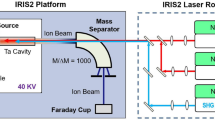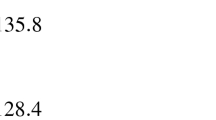Abstract
Through computer simulation on experimentally acquired optical spectra, uranium isotopic analysis by laser ablation molecular isotopic spectrometry and laser induced breakdown spectroscopy were studied. The use of only one spectral feature, either the strong UO band at 593.55 nm or the nearby U I 593.382 nm line, are similar in precisions (~ 1.5% in absolute 235U abundances). Precision improves to 0.72% with the use of a group of U atomic lines from 591.6 to 596.5 nm. The use of both molecular bands and atomic lines further advances the precision to 0.42% and compares well with the U II 424.437 nm single-line benchmark (0.48% precision).





Similar content being viewed by others
References
Mao X, Bol’shakov AA, Choi I, McKay CP, Perry DL, Sorkhabi O, Russo RE (2011) Laser ablation molecular isotopic spectrometry: strontium and its isotopes. Spectrochim Acta B 66(11–12):767–775
Mao X, Bol’shakov AA, Perry DL, Sorkhabi O, Russo RE (2011) Laser ablation molecular isotopic spectrometry: parameter influence on boron isotope measurements. Spectrochim Acta B 66(8):604–609
Russo RE, Bol’shakov AA, Mao X, McKay CP, Perry DL, Sorkhabi O (2011) Laser ablation molecular isotopic spectrometry. Spectrochim Acta B 66(2):99–104
Sarkar A, Mao X, Chan GCY, Russo RE (2013) Laser ablation molecular isotopic spectrometry of water for 1D2/1H1 ratio analysis. Spectrochim Acta B 88:46–53
Hou H, Chan GCY, Mao X, Zorba V, Zheng R, Russo RE (2015) Femtosecond laser ablation molecular isotopic spectrometry for zirconium isotope analysis. Anal Chem 87(9):4788–4796
Bol′shakov AA, Mao X, Jain J, McIntyre DL, Russo RE (2015) Laser ablation molecular isotopic spectrometry of carbon isotopes. Spectrochim Acta B 113:106–112
Wiese WL, Fuhr JR (2009) Accurate atomic transition probabilities for hydrogen, helium, and lithium. J Phys Chem Ref Data 38(3):565–719
King WH (1984) Isotopic shifts in atomic spectra, 1st edn. Plenum Press, New York
Hertel IV, Schulz C-P (2015) Hyperfine structure. In: Hertel IV, Schulz C-P (eds) Atoms, molecules and optical physics 1: atoms and spectroscopy, 1st edn. Springer, Berlin, pp 447–493
Chan GCY, Mao X, Choi I, Sarkar A, Lam OP, Shuh DK, Russo RE (2013) Multiple emission line analysis for improved isotopic determination of uranium—a computer simulation study. Spectrochim Acta B 89:40–49
Blaise J, Radziemski LJ (1976) Energy-levels of neutral atomic uranium (U I). J Opt Soc Am 66(7):644–659
Blaise J, Wyart JF, Verges J, Engleman R, Palmer BA, Radziemski LJ (1994) Energy-levels and isotope shifts for singly ionized uranium (U II). J Opt Soc Am B 11(10):1897–1929
Cremers DA, Beddingfield A, Smithwick R, Chinni RC, Jones CR, Beardsley B, Karch L (2012) Monitoring uranium, hydrogen, and lithium and their isotopes using a compact laser-induced breakdown spectroscopy (LIBS) probe and high-resolution spectrometer. Appl Spectrosc 66(3):250–261
Doucet FR, Lithgow G, Kosierb R, Bouchard P, Sabsabi M (2011) Determination of isotope ratios using laser-induced breakdown spectroscopy in ambient air at atmospheric pressure for nuclear forensics. J Anal At Spectrom 26(3):536–541
D’Ulivo A, Onor M, Pitzalis E, Spiniello R, Lampugnani L, Cristoforetti G, Legnaioli S, Palleschi V, Salvetti A, Tognoni E (2006) Determination of the deuterium/hydrogen ratio in gas reaction products by laser-induced breakdown spectroscopy. Spectrochim Acta B 61(7):797–802
Suyanto H, Lie ZS, Niki H, Kagawa K, Fukumoto K, Rinda H, Abdulmadjid SN, Marpaung AM, Pardede M, Suliyanti MM, Hidayah AN, Jobiliong E, Lie TJ, Tjia MO, Kurniawan KH (2012) Quantitative analysis of deuterium in zircaloy using double-pulse laser-induced breakdown spectrometry (LIBS) and helium gas plasma without a sample chamber. Anal Chem 84(5):2224–2231
Morgan PK, Scott JR, Jovanovic I (2016) Hybrid interferometric/dispersive atomic spectroscopy of laser-induced uranium plasma. Spectrochim Acta B 116:58–62
Chan GCY, Choi I, Mao X, Zorba V, Lam OP, Shuh DK, Russo RE (2016) Isotopic determination of uranium in soil by laser induced breakdown spectroscopy. Spectrochim Acta B 122:31–39
Smith CA, Martinez MA, Veirs DK, Cremers DA (2002) Pu-239/Pu-240 isotope ratios determined using high resolution emission spectroscopy in a laser-induced plasma. Spectrochim Acta B 57(5):929–937
Hou H, Chan GCY, Mao X, Zheng R, Zorba V, Russo RE (2015) Femtosecond filament-laser ablation molecular isotopic spectrometry. Spectrochim Acta B 113:113–118
Konjevic N (1999) Plasma broadening and shifting of non-hydrogenic spectral lines: present status and applications. Phys Rep 316(6):339–401
Mao X, Chan GCY, Zorba V, Russo RE (2016) Reduction of spectral interferences and noise effects in laser ablation molecular isotopic spectrometry with partial least square regression—a computer simulation study. Spectrochim Acta B 122:75–84
Choi I, Chan GCY, Mao X, Perry DL, Russo RE (2013) Line selection and parameter optimization for trace analysis of uranium in glass matrices by laser-induced breakdown spectroscopy (LIBS). Appl Spectrosc 67(11):1275–1284
Palmer BA, Engleman RJ, Keller RA (1980) An atlas of uranium emission intensities in a hollow-cathode discharge (LA-8251-MS), Los Alamos National Laboratory
Kaledin LA, McCord JE, Heaven MC (1994) Laser spectroscopy of UO: characterization and assignment of states in the 0 to 3 eV range, with a comparison to the electronic structure of ThO. J Mol Spectrosc 164(1):27–65
Kaledin LA, Heaven MC (1997) Electronic spectroscopy of UO. J Mol Spectrosc 185(1):1–7
Tyagi R, Zhang Z, Pitzer RM (2014) Electronic spectrum of the UO and UO+ molecules. J Chem Phys A 118(50):11758–11767
Zolfonoun E, Ahmadi SJ (2013) Application of multivariate curve resolution-alternating least squares for the determination of boron isotope ratios by inductively coupled plasma-optical emission spectrometry. Spectrochim Acta B 81:64–68
Sarkar A, Mao X, Russo RE (2014) Advancing the analytical capabilities of laser ablation molecular isotopic spectrometry for boron isotopic analysis. Spectrochim Acta B 92:42–50
Sarkar A, Karki V, Aggarwal SK, Maurya GS, Kumar R, Rai AK, Mao X, Russo RE (2015) Evaluation of the prediction precision capability of partial least squares regression approach for analysis of high alloy steel by laser induced breakdown spectroscopy. Spectrochim Acta B 108:8–14
Zeaiter M, Roger JM, Bellon-Maurel V (2005) Robustness of models developed by multivariate calibration. Part II: the influence of pre-processing methods. Trends. Anal Chem 24(5):437–445
Feng J, Wang Z, West L, Li Z, Ni W (2011) A PLS model based on dominant factor for coal analysis using laser-induced breakdown spectroscopy. Anal Bioanal Chem 400(10):3261–3271
Feilhauer H, Asner GP, Martin RE, Schmidtlein S (2010) Brightness-normalized partial least squares regression for hyperspectral data. J Quant Spectrosc Radiat Transf 111(12–13):1947–1957
Kaledin LA, Shenyavskaya EA, Gurvich LV (1986) The electronic spectrum of the uranium monoxide molecule. Russ J Phys Chem 60(4):633–635
Kaledin LA, Kulikov AN, Kobylyanskii AL, Shenyavskaya EA, Gurvich LV (1987) The relative positions of the low-lying states of the uranium monoxide (UO) molecule. Russ J Phys Chem 61(5):712–714
Dmitriev YN, Kaledin LA, Kobyliansky AI, Kulikov AN, Shenyavskaya EA, Gurvich LV (1987) Electronic spectra of diatomic molecules containing f-elements: GdO, EuF and UO. Acta Phys Hung 61(1):51–54
Fisher BT, Johnsen HA, Buckley SG, Hahn DW (2001) Temporal gating for the optimization of laser-induced breakdown spectroscopy detection and analysis of toxic metals. Appl Spectrosc 55(10):1312–1319
Zhang D, Ma X, Wang S, Zhu X (2015) Influence of ambient gas on laser-induced breakdown spectroscopy of uranium metal. Plasma Sci Technol 17(11):971–974
Emmert LA, Chinni RC, Cremers DA, Jones CR, Rudolph W (2011) Comparative study of femtosecond and nanosecond laser-induced breakdown spectroscopy of depleted uranium. Appl Opt 50(3):313–317
Lazic V, Fantoni R, Colao F, Santagata A, Morone A, Spizzichino V (2004) Quantitative laser induced breakdown spectroscopy analysis of ancient marbles and corrections for the variability of plasma parameters and of ablation rate. J Anal At Spectrom 19(4):429–436
St-Onge L, Kwong E, Sabsabi M, Vadas EB (2002) Quantitative analysis of pharmaceutical products by laser-induced breakdown spectroscopy. Spectrochim Acta B 57(7):1131–1140
Heaven MC, Nicolai JP, Riley SJ, Parks EK (1985) Rotationally resolved electronic spectra for uranium monoxide. Chem Phys Lett 119(2–3):229–233
Heaven MC (2006) Probing actinide electronic structure using fluorescence and multi-photon ionization spectroscopy. Phys Chem Chem Phys 8(39):4497–4509
Heaven MC, Barker BJ, Antonov IO (2014) Spectroscopy and structure of the simplest actinide bonds. J Chem Phys A 118(46):10867–10881
Corliss CH (1976) Line strengths and lifetimes of levels in neutral uranium. J Res Nat Bur Stand Sec A 80(1):1–7
Saunderson JL (1960) A method of uranium isotope analysis by direct reading emission spectroscopy. Talanta 6:63–70
Leys JA, Perkins RE (1966) Uranium isotope analysis by optical emission spectrometry. Anal Chem 38(8):1099–1101
Krachler M, Carbol P (2011) Validation of isotopic analysis of depleted, natural and enriched uranium using high resolution ICP-OES. J Anal At Spectrom 26(2):293–299
Edelson MC, Fassel VA (1981) Isotopic abundance determinations by inductively coupled plasma atomic emission spectroscopy. Anal Chem 53(14):2345–2347
Pietsch W, Petit A, Briand A (1998) Isotope ratio determination of uranium by optical emission spectroscopy on a laser-produced plasma—basic investigations and analytical results. Spectrochim Acta, Part B 53(5):751–761
Acknowledgements
This work was supported by the Defense Nuclear Nonproliferation Research and Development Office and the Office of Basic Energy Sciences of the U.S. Department of Energy under contract number DE-AC02-05CH11231 at the Lawrence Berkeley National Laboratory.
Author information
Authors and Affiliations
Corresponding author
Rights and permissions
About this article
Cite this article
Mao, X., Chan, G.CY., Choi, I. et al. Combination of atomic lines and molecular bands for uranium optical isotopic analysis in laser induced plasma spectrometry. J Radioanal Nucl Chem 312, 121–131 (2017). https://doi.org/10.1007/s10967-017-5197-y
Received:
Published:
Issue Date:
DOI: https://doi.org/10.1007/s10967-017-5197-y




